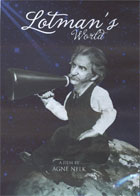
Lotman's World 2008
Distributed by Icarus Films, 32 Court St., 21st Floor, Brooklyn, NY 11201; 800-876-1710
Produced by Agne Nelk
Directed by Agne Nelk
DVD, color, 57 min., Estonian Language with English subtitles
Sr. High - Adult
Philosophy, Culture, Soviet Union, Estonia, Higher Education
Date Entered: 01/12/2010
Reviewed by Charles J. Greenberg, Cushing/Whitney Medical Library, Yale UniversityStart a discussion of philosophy in the 20th century—existentialism, phenomenology, hermeneutics, semiotics—and there is a better than even chance that your audience’s eyes glaze over or their body starts to unconsciously lean toward the nearest escape. Yet in our increasingly interdisciplinary world linked by ubiquitous data networks and numerous overlapping computer-mediated social networks representing us virtually and symbolically, a timely revival of interest in semiotics—the study of signs and symbols embedded in science and culture—seems inevitable. Lotman’s World is a multimedia biographical cornucopia about Yuri Lotman (1922-1993) and the group of followers he attracted as the first generation Soviet and Estonian semiotics adherents.
Lotman was prolific, charismatic, colorful, and outspoken: an icon of progressive philosophy of how humans think of themselves (or should think of themselves) in their world. Estonian film director Agne Nelk blends an amusing montage of visual collages, animations, and Lotman’s own radio and video appearances from his notable academic career, an era spanning rise and decline of Stalinism, Perestroika, and an emerging Estonian nationalism.
Nelk adopts a “world” or universal cultural approach in introducing the film audience to Lotman’s ideas, apparently determined to mirror the humorous, entertaining, and popular style that made Lotman an admired Russian student and eventually one of Tartu University’s most popular teachers. Lotman’s early life as a university student in St. Petersburg (Leningrad) was interrupted by frontline military service during the Nazi invasion and defensive siege. Several authentic film clips of the war front are interspersed with animated appearances of animals, insects, and cartoon characters. A voiceover narrative by Lotman and Estonian academic colleagues introduces the concept signs and signals in wartime leading to Lotman’s observation that the reapplication of wartime communication networks could serve a new philosophy of scientific inquiry. In his wartime signal service, Lotman was apparently stimulated by the functional communication patterns of insects.
Despite his self-described heroics at the war front, Lotman was forced by pervasive anti-Semitism to abandon post-graduate job-seeking in St. Petersburg for the welcoming academic environment of Estonia’s Tartu University. The film suggests that Lotman excelled as a respected educator using self-deprecating humor and student-engaged teaching, maintaining the relevancy of philosophy to current events and history. Despite Lotman’s Russian roots, this kaleidoscopic film paints him as a vociferous advocate of post-Soviet independence for Estonia and an important nationalist figure in the history of Tartu University and Estonia. Lotman himself states the importance of inquisitive students engaged in scientific inquiry and the importance of open national borders, a lecturer who firmly aligned himself with the nationalist awakening of the Baltic States in the post-Perestroika era.
The universal cultural values spoken by Lotman himself during the film—tolerance, politeness, intelligence, respect for others—are juxtaposed with Terry Gilliam–inspired cut-and-paste animations that almost always feature Lotman’s distinctive mustached headshot attached to a cartoon character, a statue, or an insect. The film presents a “Monty Python roundtable” of cartooned colleagues that pop up to introduce a facet of their respect for Lotman. Lotman himself apparently narrated early films and was recorded during television appearances, and Nelk has repurposed a variety multimedia documentation of Lotman’s activity into fast-paced, entertaining “mashups.”
As a communication message and certainly not a straight-forward biography, Lotman’s World succeeds in offering a non-specialist audience an introduction to the roots of the semiotics movement. This film is recommended for high school and college philosophy classes seeking a humorous and entertaining introduction to semiotics, as well as for history classes that focus on anti-Semitism in the Soviet Union and the modern Perestroika movement and its effect on the re-emergence of Baltic nationalism and independence for democratic states like Estonia.